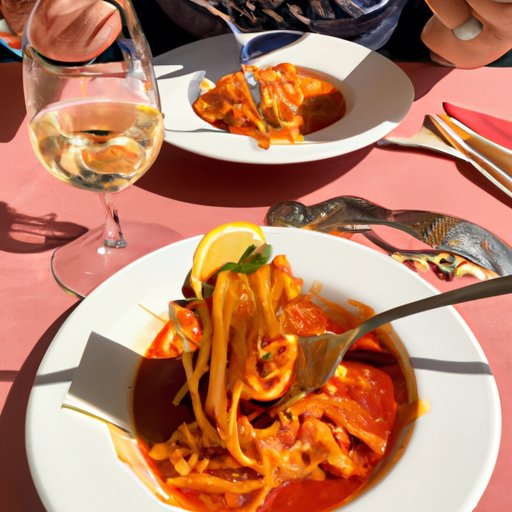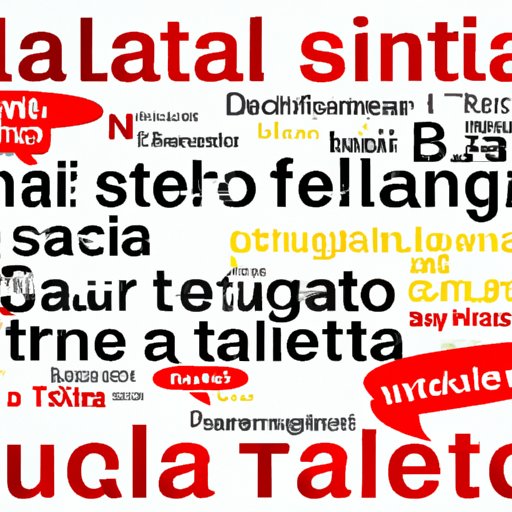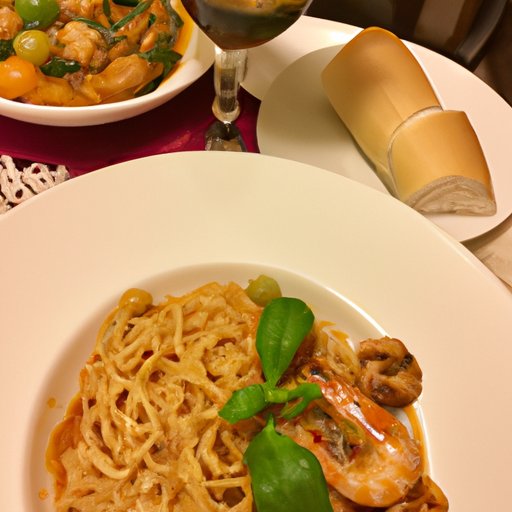Introduction
Eating in Italy is a unique experience. From the bustling streets of Rome to the quaint trattorias of Tuscany, Italian cuisine is renowned for its fresh ingredients, flavorful dishes, and vibrant atmosphere. Whether it’s your first time or you’re a seasoned traveler, learning the language of Italian food is essential for getting the most out of your Italian dining experience.
This article aims to provide an overview of Italian food culture, with useful vocabulary for ordering, conversational etiquette for dining out, and tips for enjoying meals with friends and family. Read on to learn how to master the language of Italian food.
A Beginner’s Guide to Ordering Italian Food: Essential Vocabulary for Dining Out
When it comes to ordering Italian food, there are some basic words and phrases you should know. Here are some essential Italian words and phrases to help you navigate Italian menus:
Basic Italian Words and Phrases for Eating Out:
- Ciao – Hi
- Grazie – Thank you
- Prego – You’re welcome
- Per favore – Please
- Buon appetito – Enjoy your meal
Common Italian Food Names:
- Pizza – Pizza
- Pasta – Pasta
- Risotto – Risotto
- Insalata – Salad
- Tiramisu – Tiramisu
- Gelato – Ice cream
Understanding Menu Terms:
- Antipasto – Appetizer
- Primo – First course (usually pasta or risotto)
- Secondo – Main course (meat or fish)
- Contorno – Side dish
- Dolce – Dessert
- Vino – Wine

Learning Italian Cuisine: How to Express Your Appetite in Italian
If you want to truly immerse yourself in Italian culture, you’ll need to learn how to express your appetite in Italian. Here are some useful verbs and expressions for talking about food:
Using Italian Verbs to Describe Eating Habits:
- Mangiare – To eat
- Bere – To drink
- Assaggiare – To taste
- Gustare – To savor
- Degustare – To sample
- Divorare – To devour
Popular Italian Expressions for Talking About Food:
- Ho fame – I’m hungry
- Ho sete – I’m thirsty
- È buonissimo – It’s very good
- Mi piace – I like it
- Non mi piace – I don’t like it
- Mi dispiace – I’m sorry

Perfecting the Art of Eating Italian: Tips and Tricks for Eating Like a Local
To really enjoy the true Italian experience, it’s important to understand the customs and etiquette of eating in Italy. Here are some tips and tricks for eating like a local:
Typical Italian Meal Times:
- Breakfast – 7-9 am
- Lunch – 12-2 pm
- Dinner – 8-10 pm
Table Manners in Italy:
- Wait to be seated – Italians usually wait to be seated by the waiter.
- Start with antipasti – Antipasto is served before the primo course.
- Eat slowly – Italians take their time when eating and enjoy conversation while they eat.
- Use cutlery correctly – Use the correct utensils for each course and always keep them on the plate.
- Leave something on your plate – Leaving a bit of food on your plate shows that you’ve had enough to eat.
Dietary Restrictions in Italy:
- Vegetarianism – Most restaurants offer vegetarian options, but vegans may have difficulty finding suitable meals.
- Gluten-free – Many restaurants offer gluten-free options, but it’s best to check with the waiter first.
- Nut allergies – Nuts are commonly used in Italian cooking, so be sure to inform the waiter of any allergies.
Say ‘Ciao’ to Italian Eating: Mastering the Language of Italian Food
Once you’ve mastered the basics of Italian eating, it’s time to perfect your Italian food vocabulary. Here are some common Italian food-related words to help you talk about food in Italian:
Common Italian Food-Related Words:
- Cucina – Kitchen
- Cucinare – To cook
- Ingredienti – Ingredients
- Gusto – Taste
- Sapore – Flavor
- Piatto – Dish
Basic Conversational Etiquette for Eating Out:
- Saluti – Greetings
- Ordinare – Ordering
- Chiedere – Asking
- Ringraziare – Thanking
- Pagare – Paying

Food Talk in Italy: An Introduction to Common Phrases for Eating Out
Whether you’re out for dinner with friends or enjoying a romantic meal with a loved one, knowing the right phrases can make all the difference when it comes to having a pleasant Italian dining experience. Here are some common phrases for eating out in Italy:
Common Greetings and Goodbyes:
- Ciao – Hi
- Buongiorno – Good morning
- Arrivederci – Goodbye
- Grazie mille – Thank you very much
- È stato un piacere – It was a pleasure
- Ci vediamo presto – See you soon
Asking About Ingredients and Preparations:
- Quali ingredienti ci sono? – What ingredients are there?
- Come è preparato questo piatto? – How is this dish prepared?
- Questo piatto contiene glutine? – Does this dish contain gluten?
- Questo piatto contiene latticini? – Does this dish contain dairy?
- È possibile fare una modifica? – Is it possible to make a modification?
- Posso avere un’altra porzione? – Can I have another portion?
Showing Appreciation for Delicious Meals:
- È delizioso! – It’s delicious!
- È davvero squisito! – It’s really exquisite!
- È un piatto eccellente! – It’s an excellent dish!
- Grazie per il pasto – Thank you for the meal
- Grazie per la vostra ospitalità – Thank you for your hospitality
- Grazie per l’ottima cena – Thank you for the wonderful dinner
Bon Appétit! Useful Italian Phrases for Enjoying Meals with Friends and Family
Finally, here are some useful Italian phrases for enjoying meals with friends and family:
Saying ‘Cheers’ to Celebrate with Drinks:
- Cin cin – Cheers
- Alla salute – To your health
- Ai tuoi – To you
- Ai nostri – To us
- Buona fortuna – Good luck
- Cento anni – May you live 100 years
Complimenting Dishes and Chefs:
- È un piatto speciale – It’s a special dish
- Sei un bravo cuoco – You’re a good cook
- È una ricetta fantastica – It’s a fantastic recipe
- È una vera delizia – It’s a real delight
- Sei un maestro della cucina – You’re a culinary master
- È un piacere mangiare qui – It’s a pleasure to eat here
Polite Ways to Ask for the Check:
- Il conto, per favore – The check, please
- Posso avere il conto? – Can I have the check?
- Vorrei pagare – I would like to pay
- Quanto devo? – How much do I owe?
- Vorrei pagare con carta di credito – I would like to pay with a credit card
- Quanto costa? – How much does it cost?
Conclusion
Eating in Italy is an unforgettable experience. From understanding menu terms to mastering polite conversation, learning the language of Italian food is essential for getting the most out of your Italian dining experience. With the help of this guide, you’ll be able to enjoy Italian food like a local and say ‘ciao’ to Italian eating.
(Note: Is this article not meeting your expectations? Do you have knowledge or insights to share? Unlock new opportunities and expand your reach by joining our authors team. Click Registration to join us and share your expertise with our readers.)
